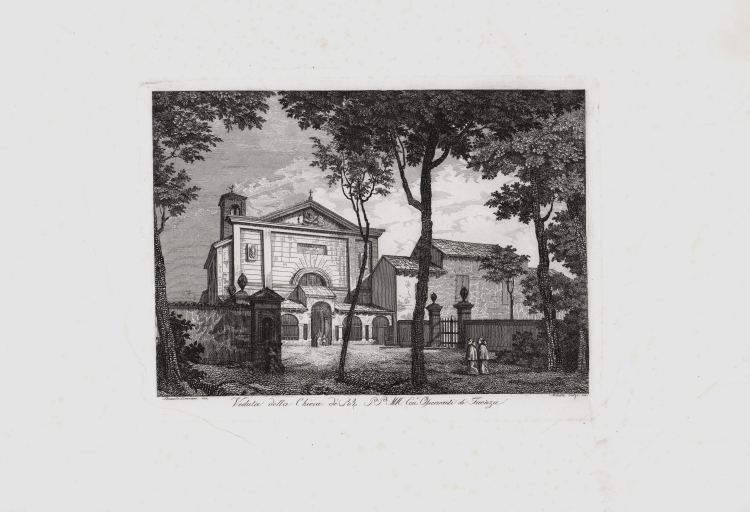



| Reference: | S47215 |
| Author | Achille CALZI |
| Year: | 1845 ca. |
| Zone: | Faenza |
| Printed: | Faenza |
| Measures: | 252 x 190 mm |


| Reference: | S47215 |
| Author | Achille CALZI |
| Year: | 1845 ca. |
| Zone: | Faenza |
| Printed: | Faenza |
| Measures: | 252 x 190 mm |
Acquaforte, circa 1845/50, firmata in lastra in basso a destra.
Da un dipinto di Romolo Liverani (Faenza 1809 – 1872) pittore, scenografo e decoratore di interni, concittadino di Scalzi.
Appartiene ad una serie di vedute che Acille Scalzi realizza doppo il 1844, al suo ritorno a Faenza. Derivano tutte da dipinti dell’amico Liverani.
Achille Calzi (Faenza, 15 giugno 1811 – Faenza, 24 aprile 1850), considerato un disegnatore elegante, di grande finezza e con un segno nitido, fu abile incisore; artista di sensibilità romantica, fu pittore di opere sacre, storiche e letterarie, ritratti e miniature. È imparentato con l'altro Achille Calzi, anche lui pittore italiano. Scalzi fu allievo del pittore Alessandro Ricciardelli, per la pratica del disegno e di miniatura, poi frequentò la Scuola di disegno di Faenza sotto la direzione dell'incisore Giuseppe Marri. Trasferitosi a Roma nel 1836, ottenne la protezione di Tommaso Minardi; nel 1839 partecipa al concorso dell’Accademia dei Virtuosi al Pantheon vincendo il premio per l'incisione a contorno e mezza macchia. Fu poi chiamato dal calcografo Luigi Bardi a collaborare nella pubblicazione delle opere della Galleria palatina per il volume Imperiale e reale Galleria Pitti. Ritornato nel 1844 a Faenza sposa la contessa Maria Bandini e continua l'attività, segnalandosi per la raffinata esecuzione dei ritratti. Stringe amicizia con molti artisti faentini, come Romolo Liverani con il quale collabora per il primo numero del Lunêri di Smémbar, e incide alcune sue celebri vedute di Faenza.
Bellissima prova, impressa su carta coeva, in perfetto stato di conservazione. Molto rara.
Achille CALZI (Faenza, 15 giugno 1811 – Faenza, 24 aprile 1850)
|
He was born in Faenza on June 15, 1811, the son of Giuseppe and Teresa Sansoni. He completed classical studies at the seminary in Faenza, following lessons in rhetoric, eloquence and history; first he attended the studio of painter Alessandro Ricciardelli privately for drawing and miniature practice, then the School of Drawing in Faenza under the direction of engraver Giuseppe Marri. In 1834 he executed the portrait of Jacopo Mazzoni for the Biographies and Portraits of XXIV illustrious men of Romagna. He then moved to Rome in 1836 under the tutelage of Tommaso Minardi, and thus became known for his good qualities and finesse of sign, as in the drawing Il Tasso legge la Gerusalemme liberata ad Eleonora d'Este; in 1839 he participated in the competition of the Accademia dei Virtuosi at the Pantheon, winning the prize for the outline and half-spot engraving La predica di Gesù Cristo nel deserto. He was then called by the chalcographer Luigi Bardi to collaborate in the publication of the works of the Palatine Gallery for the volume Imperial and Royal Pitti Gallery. After 1843 he moved to Florence to follow the edition and engraved several subjects (Dal Francia, Garofalo, Bassano, Tintoretto). Returning in 1844 to Faenza, he married Countess Maria Bandini and continued his activity, noting his refined execution of portraits. He formed friendships with many Faentine artists, such as Romolo Liverani, with whom he collaborated on the first issue of Lunêri di Smémbar, and engraved some of his famous views of Faenza. When his wife and daughter died, he moved to Florence but, after falling ill, returned to Faenza and died there.
|
Achille CALZI (Faenza, 15 giugno 1811 – Faenza, 24 aprile 1850)
|
He was born in Faenza on June 15, 1811, the son of Giuseppe and Teresa Sansoni. He completed classical studies at the seminary in Faenza, following lessons in rhetoric, eloquence and history; first he attended the studio of painter Alessandro Ricciardelli privately for drawing and miniature practice, then the School of Drawing in Faenza under the direction of engraver Giuseppe Marri. In 1834 he executed the portrait of Jacopo Mazzoni for the Biographies and Portraits of XXIV illustrious men of Romagna. He then moved to Rome in 1836 under the tutelage of Tommaso Minardi, and thus became known for his good qualities and finesse of sign, as in the drawing Il Tasso legge la Gerusalemme liberata ad Eleonora d'Este; in 1839 he participated in the competition of the Accademia dei Virtuosi at the Pantheon, winning the prize for the outline and half-spot engraving La predica di Gesù Cristo nel deserto. He was then called by the chalcographer Luigi Bardi to collaborate in the publication of the works of the Palatine Gallery for the volume Imperial and Royal Pitti Gallery. After 1843 he moved to Florence to follow the edition and engraved several subjects (Dal Francia, Garofalo, Bassano, Tintoretto). Returning in 1844 to Faenza, he married Countess Maria Bandini and continued his activity, noting his refined execution of portraits. He formed friendships with many Faentine artists, such as Romolo Liverani, with whom he collaborated on the first issue of Lunêri di Smémbar, and engraved some of his famous views of Faenza. When his wife and daughter died, he moved to Florence but, after falling ill, returned to Faenza and died there.
|